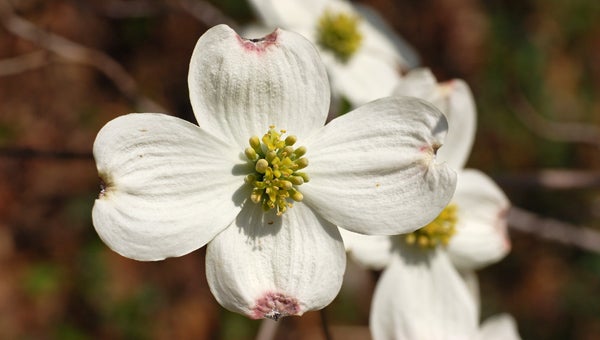Flowering dogwood has various historical significance
Published 11:22 am Tuesday, April 5, 2016

The flowering dogwood is a small, deciduous tree native to eastern and central North America that blooms in late March to early April. (Contributed)
By EMILY D. COOK / Community Columnist
The Flowering Dogwood, Cornus florida, is one of my favorite trees. Why, you ask? The unique flower, the historical uses for it and the time of year that it blooms are a few reasons.
Want to know more? Great! Let me tell you a little bit about it and then you can come look for it at Oak Mountain State Park on your next visit. We have several that are easy to find.
The flowering dogwood is a small deciduous tree that only reaches about 33 feet in height, and has a trunk diameter of about 1 foot.
It is often wider than it is tall. The leaves of the flowering dogwood are about 5 inches in length and 2–2 ½ inches wide. They will turn bright red in fall.
The flowers are small and inconspicuous greenish yellow with 20 flowers in a flower-head.
It is surrounded by four large white, pink or red petals.
Most wild trees have white petals.
Dogwoods can be found in moist acidic soils with afternoon shade but must have good morning sun.
It is native to eastern and central North America. They are heat sensitive, so you wouldn’t want one to be a near a parking lot.
Many people plant the flowering dogwood as an ornamental in their yards.
Historical uses of the dogwood include inks and scarlet dye, and for items like golf club heads, mallets, jeweler’s boxes, butcher blocks and tool handles.
It was even thought to be able to cure the mange in dogs, which is how some people think it got its name.
In the southern part of their range, they bloom in late March to early April, typically around Easter.
Legend has it that the flowering dogwood once grew large enough that they built the cross for Jesus from it and this made the dogwood sad.
Today the dogwood remains small in stature, has four petals in the shape of a cross and at the end of each petal is a nail dent stained with blood, and in the center is a crown of thorns. True or not, we may never know, but it is a cool legend.
Please remember that you keep Alabama State Parks open by visiting them. Thank you for your support.









